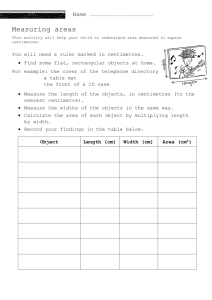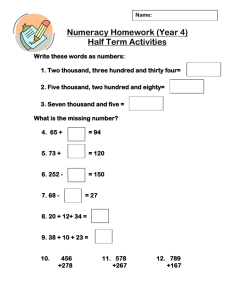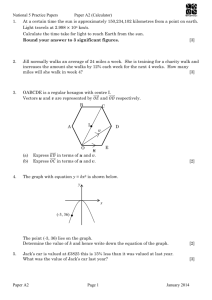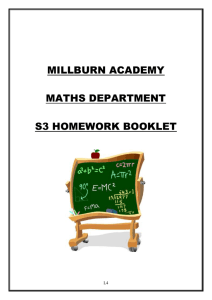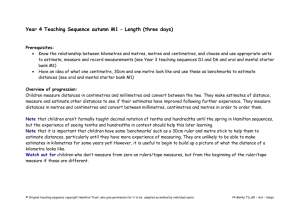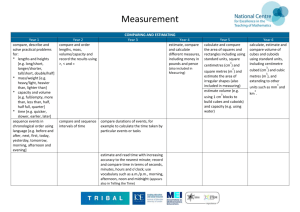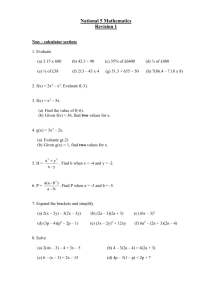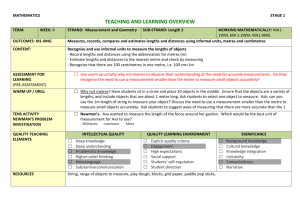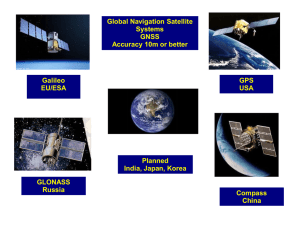Area
advertisement
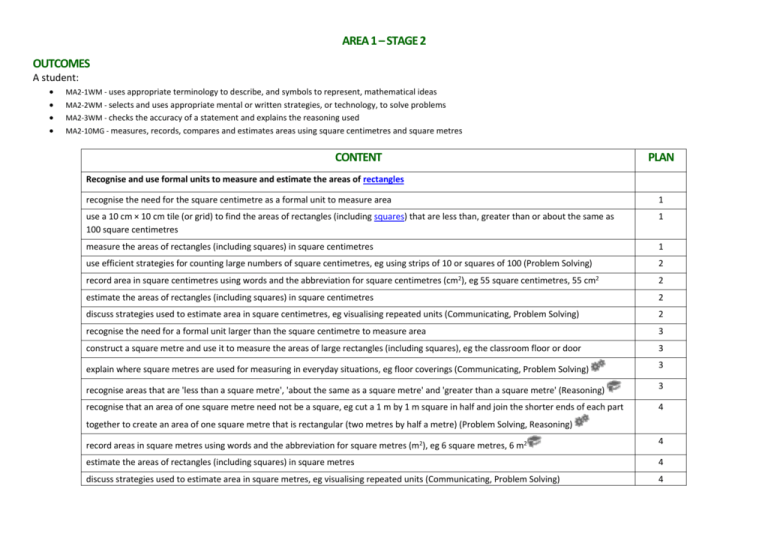
AREA 1 – STAGE 2 OUTCOMES A student: MA2-1WM - uses appropriate terminology to describe, and symbols to represent, mathematical ideas MA2-2WM - selects and uses appropriate mental or written strategies, or technology, to solve problems MA2-3WM - checks the accuracy of a statement and explains the reasoning used MA2-10MG - measures, records, compares and estimates areas using square centimetres and square metres CONTENT PLAN Recognise and use formal units to measure and estimate the areas of rectangles recognise the need for the square centimetre as a formal unit to measure area 1 use a 10 cm × 10 cm tile (or grid) to find the areas of rectangles (including squares) that are less than, greater than or about the same as 100 square centimetres 1 measure the areas of rectangles (including squares) in square centimetres 1 use efficient strategies for counting large numbers of square centimetres, eg using strips of 10 or squares of 100 (Problem Solving) record area in square centimetres using words and the abbreviation for square centimetres (cm2), eg 55 square centimetres, 55 cm2 2 2 estimate the areas of rectangles (including squares) in square centimetres 2 discuss strategies used to estimate area in square centimetres, eg visualising repeated units (Communicating, Problem Solving) 2 recognise the need for a formal unit larger than the square centimetre to measure area 3 construct a square metre and use it to measure the areas of large rectangles (including squares), eg the classroom floor or door 3 explain where square metres are used for measuring in everyday situations, eg floor coverings (Communicating, Problem Solving) 3 recognise areas that are 'less than a square metre', 'about the same as a square metre' and 'greater than a square metre' (Reasoning) 3 recognise that an area of one square metre need not be a square, eg cut a 1 m by 1 m square in half and join the shorter ends of each part 4 together to create an area of one square metre that is rectangular (two metres by half a metre) (Problem Solving, Reasoning) record areas in square metres using words and the abbreviation for square metres (m2), eg 6 square metres, 6 m2 4 estimate the areas of rectangles (including squares) in square metres 4 discuss strategies used to estimate area in square metres, eg visualising repeated units (Communicating, Problem Solving) 4 AREA 2 – STAGE 2 OUTCOMES A student: MA2-1WM - uses appropriate terminology to describe, and symbols to represent, mathematical ideas MA2-2WM - selects and uses appropriate mental or written strategies, or technology, to solve problems MA2-10MG - measures, records, compares and estimates areas using square centimetres and square metres CONTENT PLAN Compare the areas of regular and irregular shapes by informal means (ACMMG087) measure the areas of common two-dimensional shapes using a square-centimetre grid overlay, eg measure the area of a regular hexagon 5 compare how different placements of a grid overlay make measuring area easier or harder, eg (Problem Solving) 5 develop strategies for counting partial units in the total area of the shape, eg determine two or more partial units that combine to form one 6 whole unit (Communicating, Problem Solving) measure the areas of irregular shapes using a square-centimetre grid overlay, eg 6 compare two or more areas by informal means, eg using tiles or a square-centimetre grid overlay 7 explain why two students may obtain different measurements of the area of the same irregular shape (Communicating, Reasoning) 7 Compare objects using familiar metric units of area (ACMMG290) estimate the larger of two or more rectangular areas (including the areas of squares) in square centimetres and then measure in square centimetres to compare the areas 8 estimate the larger of two or more rectangular areas (including the areas of squares) in square metres and then measure in square metres to compare the areas 8 MISSING PLANS
